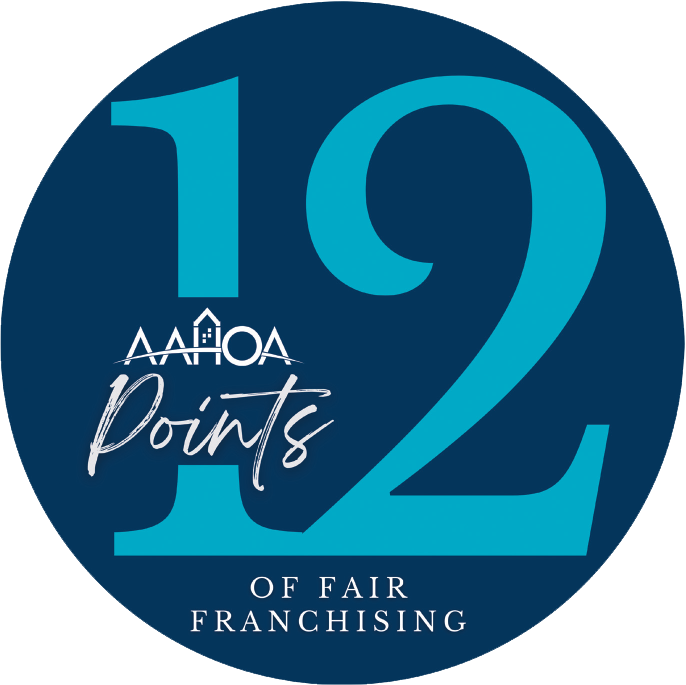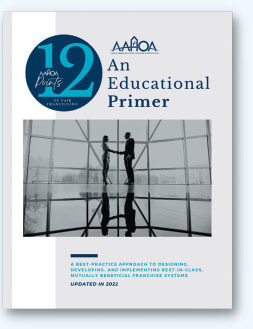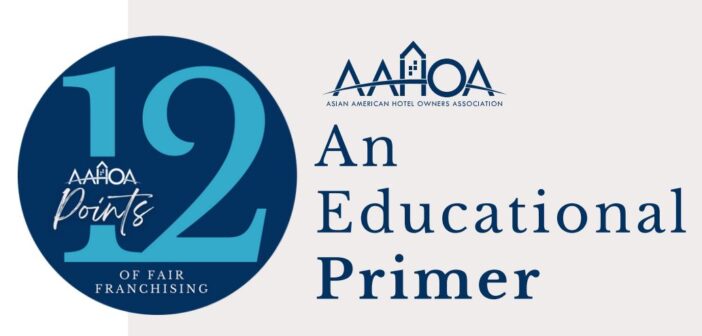Educating AAHOA Members on mutually beneficial franchise systems
This is the full interview with committee members. The version that appeared in the June issue of Today’s Hotelier was an abridged Q&A, due to space constraints.
 In 1998, AAHOA identified certain best practices for the hospitality franchise system. Those best practices were called the 12 Points of Fair Franchising (“12 Points”), and AAHOA has continuously updated them to reflect business changes and the long-term, mutually beneficial relationship between industry franchisors and franchisees.
In 1998, AAHOA identified certain best practices for the hospitality franchise system. Those best practices were called the 12 Points of Fair Franchising (“12 Points”), and AAHOA has continuously updated them to reflect business changes and the long-term, mutually beneficial relationship between industry franchisors and franchisees.
Because of the changing business environment post-COVID-19 and the ever-evolving need to educate AAHOA Members, AAHOA recently revisited the 12 Points, reviewing them carefully to ensure they’re relevant and reflective of industry changes and evolution.
The revised 12 Points continue AAHOA’s vision to be the foremost resource and advocate for America’s hotel owners by acting as an educational primer for hospitality franchisors and AAHOA Members (current and future hospitality franchisees) to discuss and use to continue designing, developing, and implementing best-in-class, mutually beneficial franchise systems.
This month’s issue is all about franchising, so let’s take a deep dive into the 12 Points with AAHOA Members who served on the 12 Points of Fair Franchising Ad Hoc Committee, which was responsible for updating and revising the 12 Points along with the help, support, and input of the AAHOA Board of Directors.
AAHOA recognizes that brands are business partners and hopes to continue the best-practice franchise approach consistent with the spirit of the updated 12 Points.
Why was it essential for the committee to review and revise the 12 points?
 Rahul Patel, 12 Points of Fair Franchising Committee Chair and AAHOA Florida Regional Director:
Rahul Patel, 12 Points of Fair Franchising Committee Chair and AAHOA Florida Regional Director:
They were published in 1998. We recently updated them to be more relevant to our hoteliers and focus on the need for education around the franchisor-franchisee relationship. AAHOA continually strives to meet the new demands of the hotel ownership landscape.
 Bharat Patel, CHO, CHIA, AAHOA Vice Chairman:
Bharat Patel, CHO, CHIA, AAHOA Vice Chairman:
The 12 Points have served as the “gold standard” for franchising in our industry and other franchise-based industries. Even Congress has used our 12 Points to consider various franchising laws and rules. The updated 12 Points arm our members with better information and education when negotiating with brands.
 Dr. Jay S. Patel, Author (“Franchising Is it Fair? How to Negotiate an Equitable Franchise Agreement”) and AAHOA Franchise and Industry Relations Committee Past Chair:
Dr. Jay S. Patel, Author (“Franchising Is it Fair? How to Negotiate an Equitable Franchise Agreement”) and AAHOA Franchise and Industry Relations Committee Past Chair:
Many AAHOA Members, including my parents from the first generations, lacked the knowledge to read and understand franchise agreements. Our second and third generations are much more educated and sophisticated and better understand what they’re signing. The 12 Points help guide prospective and current franchisees on equitable franchise agreements.
 Akshat Patel, Former AAHOA North Carolina Regional Director:
Akshat Patel, Former AAHOA North Carolina Regional Director:
The original 12 Points have been around a while. Over time, many areas of the points changed, so it was important to review, revise, and give it a fresh look.
 Vimal Patel, Founder and CEO, QHotels Management:
Vimal Patel, Founder and CEO, QHotels Management:
The entire business model changed during the past decade. We need updates and revisions that meet today’s business criteria so hoteliers can educate themselves and make sound business decisions before investing with brands.
 Navnit Patel, RPh, CHO, Principal, Marquee Hospitality:
Navnit Patel, RPh, CHO, Principal, Marquee Hospitality:
A lot has transpired in the industry and AAHOA since the original 12 Points were created and adopted by AAHOA. Since then, we’ve had tremendous growth and many updates in the franchising model.
 Sandip C. Patel, CEO, Crossroads Hospitality, Inc.:
Sandip C. Patel, CEO, Crossroads Hospitality, Inc.:
AAHOA’s original 12 Points were historic and much-needed when they were first introduced, but “fair franchising” is a direction, not a destination. The hotel marketplace constantly changes, especially in the post-pandemic era. The elements of “fair franchising” must keep changing to keep pace and properly reflect today’s sophisticated business world. AAHOA Members can now be more informed and confident as they consider new brand relationships or renew existing ones.
 Keith Miller, Principal, Franchisee Advocacy Consulting:
Keith Miller, Principal, Franchisee Advocacy Consulting:
AAHOA’s updated 12 Points create opportunities to strengthen the relationship between franchisors and franchisees. AAHOA Members have access to an excellent resource, and these franchise best practices will help members take this path to entrepreneurship to the next level.
WHY ARE THE 12 POINTS IMPORTANT FOR AAHOA MEMBERS AND BRAND PARTNERS?
Rahul Patel: The 12 Points are vital in bringing balance, awareness, and education to the franchisee-franchisor relationship. We can’t do business without each other. A fair relationship with mutual understanding contributes to financial success on both sides.
Dr. Jay S. Patel: Franchisors who question the intent should ask themselves: if you decided to flip position and become a franchisee instead of a franchisor, would you sign the agreement “as is” or would you want to use the 12 Points to negotiate for the franchise you’re buying?
Vimal Patel: Both parties must be profitable. AAHOA Members must be aware of these 12 points’ financial value and shortfalls to help determine the profitability and sustainability of the asset value in the future.
Navnit Patel: This is a long-term partnership between AAHOA Members and Brand partners. It’s mutually beneficial for both to understand each other’s goals and collaborate to achieve success for both parties.
Keith Miller: To succeed as a brand and sustain that success long term, both the franchisees and franchisors need to realize good returns on their investments. The 12 Points put a stake in the ground and provides a framework for what AAHOA defines as best-in-class practices to make both sides better and stronger long term.
WHICH SPECIFIC POINT DO YOU THINK IS THE MOST IMPORTANT FOR AAHOA MEMBERS TO PAY ATTENTION TO AND WHY?
Rahul Patel: Point No. 7: Maintaining and building relationships with franchisees as true and equal partners. Through the ears of FACs and franchise associations, brands should listen and work through hotel owners’ concerns to demonstrate a true partnership. The members and owners elected FACs. This point covers amenity creep, the biggest issue franchisees have voiced over the years.
Dr. Jay S. Patel: Point No. 2: Impact and encroachment. Once you become stabilized and successful within a particular market, others are always looking to encroach into your territory. Absolutely nothing wrong with this, as these are the guiding principles of great developers. However, at least know how to negotiate an area of protection from competing for the same brand or cross brands within the same system to protect your growth and bottom line.
Akshat Patel: Point No. 1: Termination rights and LDs. Members should be aware of and educated on their or brand’s termination rights and the LDs they will pay if terminated or if a member decides to switch brands.
Vimal Patel: Point No. 8: Dispute resolution. Each year isn’t going to be the same, therefore, the financial condition will change. There’ll be times when we’ll have to decide what’s best for us, so during such circumstances, we must know the brands would work with us, be able to navigate in difficult times and find an amicable resolution that’s fair to both parties.
Navnit Patel: All points are equally important to members, however, during the last two years with the pandemic, many members have echoed feelings on Points 5 and 6. Owners have had continuous profit margin declines with brand mandates, expenses, fees, etc., continuing to climb.
Sandip C. Patel: Every point addresses an important and unique protection, but members should be especially familiar with point No. 2, which addresses the geographic area of protection. This is essential today, as more brands are introduced and compete for the same demographic customer. The look and amenities of these new brands may be different, but they’re diluting market share for each other. For example, they’re drawing reservations from the same online system. That impacts and can detract from our bottom line, so we need to understand how we’re protected as owners.
HOW DO THE 12 POINTS WORK TOGETHER TO PAINT A COHESIVE PICTURE?
Rahul Patel: The 12 Points affirm the commitment of the franchisee to operating the hotel and franchisors to help franchisees operate a profitable business partnership.
Bharat Patel: Hotel owners know there isn’t just one formula for success. That’s because our business is part art and part science. The science is numbers, while the art is instinct. Everyone puts those factors together differently because everyone has different opportunities and challenges.
Dr. Jay S. Patel: Education! Understanding what each party is asking from each other before each side agrees to execute the agreement. It’s the fundamental principle of good business. Franchising has been around for decades. This is 2022, and the time has come for change. Know when to walk away if you feel the brand isn’t willing to give basic protections on some of the simplest principles of good faith and fair-dealing practices.
Vimal Patel: The 12 Points pinpoint which hotel brands fit the criteria in a particular market with that franchisee. This way, AAHOA Members can assess their options and are not pressured in signing a contract with a specific brand.
 Lina Patel, CHO, Female Director, Eastern Division:
Lina Patel, CHO, Female Director, Eastern Division:
Today, the bridge between us has stabilized in understanding each other’s needs. The current 12 Points are mainly for newcomers entering the industry. All points have been negotiable and utilized by many members. We’re all here to make money, save money, and invest in our future.
Sandip C. Patel: We’re all familiar with the saying that the whole is greater than the sum of its parts. Together, members are smarter, more secure, and more successful. That’s how the 12 Points work. Individually, they touch on several aspects of a hotel franchise – such as legal, marketing, and financial. By studying the 12 Points carefully and becoming familiar with them, you can be the best possible franchise owner and operator.
Keith Miller: It’s about creating a balance in the relationship so all stakeholders see returns on their investments. Without this balance, the relationship becomes unsustainable. I fear we’re getting to that point in the franchise industry where the next generation isn’t taking over the family franchised business because it’s too much effort for too little return. That’s a leading indicator of imbalance in the industry, signaling that our current path is not sustainable. The 12 Points provide a framework for that balance.
WHAT DO YOU WANT TO SEE AAHOA ACCOMPLISH WITH THE REVISED 12 POINTS?
Rahul Patel: The 12 Points raise awareness of the importance of trust and communication between franchisees and franchisors, bring equilibrium to the franchise model, and ensure profitability and mutual success for both parties.
Bharat Patel: I realize very few things in life improve when done in excess, however, communication does. I hope the updated 12 Points are the catalyst for renewed conversations between owners and brands for “fairer” franchising.
Dr. Jay S. Patel: It’s an educational primer. Franchisees have longed to have the principle guidelines on what they should negotiate. One may never get all 12 Points in a franchisee’s favor, but both sides will come to a mutually agreeable partnership by discussing each point and negotiating on a case-by-case basis. I’m confident most, if not all, franchisors will lean toward some of the 12 Points.
Franchisees from all segments of the franchise world, outside of hospitality, are using AAHOA’s 12 Points as a guide, impacting how this business model will change after 2022.
Akshat Patel: Educate members on the importance of the 12 Points, so when members sign any franchise agreement, they know what to look for. Make working relationships stronger and work together with brands to achieve the maximum possible 12 Points.
Navnit Patel: I’d like AAHOA to have a meaningful and transformational dialogue with the brands to help members and brands achieve long-term success. Continue to have the 12 Points at the forefront; don’t let them fade away.
Sandip C. Patel: The new 12 Points can be the foundation for new, candid conversations between owners and brands.
Keith Miller: Hotel brands willing to make a mutually beneficial franchise system will stand out and receive more franchise sales, creating movement by other brands to more readily compete.
WHY DO YOU PERSONALLY SUPPORT THE 12 POINTS?
Rahul Patel: AAHOA Members are completely invested in the hotel industry; it’s what made us financially successful in our ongoing pursuit of the American Dream. If these mutually beneficial relationships aren’t successful, we’ll face a serious crisis as an industry. However, on the contrary, if we’re successful, our industry will see a new era in which both parties will achieve success, growth, and collaboration, now and into the next generation.
Bharat Patel: Hotel owners know that to be successful, you must always operate your property from the guest’s perspective. Similarly, the 12 Points should remind brands they must operate from the perspective of their franchisees for them to be successful.
Dr. Jay S. Patel: I continue to constantly advocate for my fellow franchisees. The power to negotiate your agreement is within you, not anyone else, but you can’t negotiate if you have no clue what it is you want to negotiate. This tool serves the intended purpose.
Akshat Patel: It’s a two-way street. The revised 12 Points are fair and all brands may not agree on every point, but this is just the beginning as we figure out a solution to have a win-win situation for both.
Navnit Patel: They’re an education starting point for our members, a grading system of the brands, and a negotiating tool for potential franchisees. The 12 Points can potentially apply to any franchise industry/model, not just the hospitality industry, which is a great accomplishment. I give credit to all the committee members and AAHOA staff for the time and hard work dedicated to accomplishing this task.
Sandip C. Patel: Anything good for owners should also be good for brands – and our whole industry. The 12 Points are an essential guide in ensuring brands consult with owners, not just making mandates. AAHOA can be proud of our leadership and progress on fair franchising, but we shouldn’t be satisfied.
Keith Miller: The reintroduction of the 12 Points is a transformational moment in the lodging industry. It’ll also shine a light on the franchise industry to bring new focus to the mutual need for success – a measuring stick, so to speak. Hopefully, this is just the beginning of a transformation in the overall franchise industry.
Access the Educational Primer
Download AAHOA’s 12 Points of Fair Franchising by visiting AAHOA.com/12Points to learn more.





